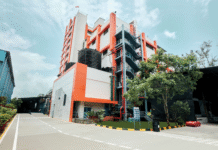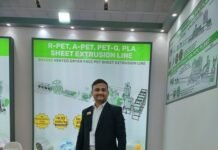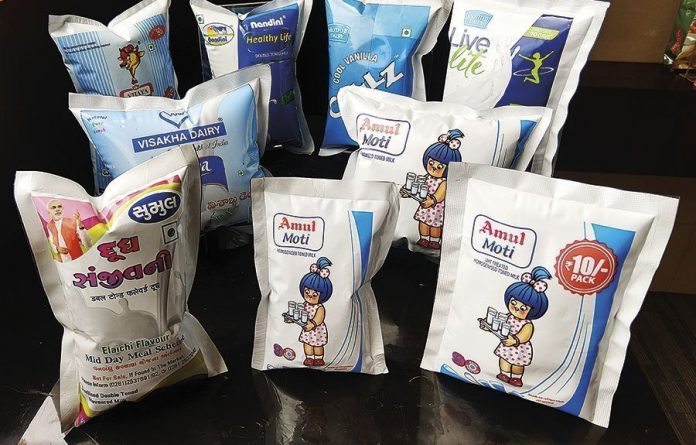
When we wrote our first story about Parakh Agro and its flexible packaging plant in Bhandgaon near Pune, exactly ten years ago for our July 2009 issue, Prakash Parakh said to us, “There is no doubt about the existence of a real food processing industry in the country and in the packaged food market there is scope for everyone, as it is not a fully mature market. From this comes our packaging story.”
We retell and update our story on Parakh Agro and its Parakh Flexipack division based on a recent visit to its new office building in the center of Pune and to the modernized and expanded packaging plant in Bhandgaon. At the Pune headquarters we had a long discussion about the company and more specifically how its sees flexible packaging growth and sustainability with the third generation director of Parakh Agro, Harshal Parakh and the chief executive officer of Parakh Flexipacks, Vinay Nalawade. It is always inspiring to revisit a company that has grown its businesses and continues to explore new markets with the new generation emerging with real leadership and responsibility.
In 2017-18, the Parakh Group was named as the fastest growing mid-size Indian FMCG company by Fortune India magazine. At its fabulous new office building in Pune, Harshal Parakh described the Parakh group as one that began 54 years ago as a Maharashtra-based trading house that traded everything, right from cloth to grain. “In the early 1980s we started manufacturing food products in our own plants with a focus on traditional products such as wheat flour and dals (lentils) and edible oil that require hygienic processing, sorting, packaging and distribution.” It pioneered the use of flexible packaging pouches for edible oil and entered a joint venture with Cargill for edible oil. The joint-venture also set up a flexible packaging plant with a W&H blown film line and a W&H CI flexo press. Parakh’s stake in the Cargill-Parakh joint-venture was divested to Cargill in 2005 which acquired the edible oil plants along with the flexible packaging plant.
In 2006 Parakh Agro renewed its focus on manufacturing and distribution of wheat flour and pulses.

Parakh says, “In 2008, we started a new packaging unit as a backward integration for our food plants. With our understanding from a food product brand owner’s point of view, we understood the need for good packaging and especially with need of a good pack for our 10 kilogram atta (wheat flour) distribution and retail. Many converters were producing 5 kilo packs but the 10-kilogram pack was a challenge.” We were the first to produce a 10 kilogram atta pack and the only ones for a long time.
Parakh Agro continued to grow its food business from milling 150 tons a day of wheat to becoming the largest wheat flour supplier in the country with a wheat milling capacity of 2,100 tons a day currently. Its milling capacity for pulses has also grown to what is now 1,000 tons a day.
Although Parakh Agro’s non-compete clause with Cargill expired in 2012, it re-entered the oil segment several years later, in August 2017. “We started refining edible oil again from zero and in the first full year of production till March of this year we clocked at about Rs. 700 crore,” says Parakh, adding, “We are also in the downstream side of edible oil processing producing by-products that are used in paints and pharmaceuticals. Apart from the food and edible oil segments and flexible packaging, we are also in the renewable energy industry with windmills, real estate development and stationery.”
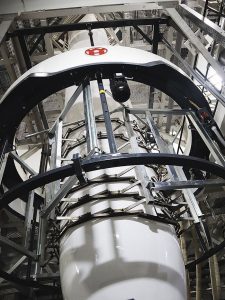
Sustainability & ‘Growing Together’
Parakh continues, “In 2016 we came up with a new logo and concept – ‘Growing Together’ which also incorporates our sustainability initiatives. This has its origin with our grandfather who believed in growing together with our product suppliers who are seen as partners. At the packaging end all our suppliers are our partners. When we started this initiative we also came up with our windmill strategy. Initially our 8.3 megawatts of windmill power which can supply the electrical energy to 12,500 houses was part of the grid and now with the changes in regulations, we are increasingly using this clean energy for our captive needs.
“Sustainability was also our outlook on the packaging side as proponents of CI flexo which we thought would catch on in the country much sooner than it actually has. Flexo has eventually arrived in the past couple of years in a big way and now seems to be finally catching on.
“Over the years as food brand owners we look at how we are selling our products. Our own people are personally visiting about 200,000 shops each week and we get first-hand information of which retailers are buying product and at what frequency. Our google map also shows us who is not buying our product at all. The point of having this integration and sales force automation was that we wanted first-hand information from our customer. In the last couple of years green packaging is being demanded from a small segment of our customers and these are not just the cosmopolitan large organized retailers. We’ve started going that way and have for instance introduced our atta in reusable plastic jars and in some cases started using paper packaging with the appropriate barrier coatings.
Paper sacks
As a food brand owner, Parakh Agro has explored various sustainable options. As Parakh explains, the company is ready for small packs and even larger packs with paper sacks. Trials with 100% paper sacks with coatings developed in Sweden by BillerudKorsnas were packed with food products in the factory and loaded on trucks to Pune and Chennai. However apart from the successful logistics trials, one of the issues is whether the smaller shopkeepers can keep this kind of packaging in a dry place and whether this kind of packaging can withstand being kept out in the sun day after day. Parakh Flexipack has done a great deal of development and R&D with EB coatings as well and there is ongoing development in this area.
Parakh Agro is open to discuss and to share its developments with the industry. Parakh says, “We want to learn from each other. To create or come up with a new film or packaging is one thing but we have always wanted to share what we are learning with brand owners and our suppliers and others in order to get closer. In the last one year, we have tried to engender a more structured cooperation style within the flexo industry. Other companies also have insights that could help us.” Training, food safety and new materials are where the Indian converters could learn from each other. Both Parakh and Nalawade would like to support the growth of the flexo technical association in India and feel that more converters could take part. The focus of the new IFIA would be mainly on training and knowledge sharing in the Indian flexo industry as that’s the missing link.
Extended producer responsibility – EPR
The Parakh group is one of the very few in Maharashtra today that has been paying a fee to the government for collection of plastic waste at both ends – as brand owners and as a flexible packaging company. Nalawade explains, “We have been doing this for long before the waste control order implementation. It came to us in the packaging side first and then we took it up on our food processing and retailing side.
“However, as a part of EPR it is sometimes unclear if we are collecting 20% of the waste (or paying for that amount to an agency for collecting plastic waste), if that is adequate or if we are doing enough. We are filling out quarterly reports on this on the basis of the government nominated agency that we are paying for what we believe is 20% of the flexible packaging we are supplying within Maharashtra.”
Packaging growth based on detailed strategies
Parakh Agro has grown in double digital in its food business and at an even higher rate in the packaging business. However, although the packaging business requires the highest investment the margins and profits have not kept up with its growth according to Nalawade and Parakh, who says, “When we were smaller, 20% compounded growth was easier and although it’s not as easy now we still want and can achieve 20-25% growth. Being innovative and avoiding delays in expansion is not enough. We need to be profitable and since our strategy is very specific and detailed we can look only two or three years ahead. We tend to make quarterly, 6 monthly and annual plans although nowadays with the longer lead times for delivery of machines we do need to think a bit further ahead in some cases.”
Pioneers in flexo and barrier films
The demand for packaging from the consumer product companies has become increasingly fragmented. “However our direction is right,” says Parakh, “Since we have a constant spend on how to make each and every product sustainable. We have a focussed sector penetration and are ready for changes. We are more and more known in the market and we are known in the right way because we are pioneers in the segments of barrier films and high resolution flexo printing on various substrates”
Nalawade explains further by saying, “Many of the barrier film innovations in partnership with the polymer suppliers in the past decade such as 105 micron film going down to 65 microns were done with large CPG companies at Parakh Flexipacks. Even our in-house prepress using Kodak Prinergy and Kodak Flexcel NX were path breaking as is our in-house automated ink making plant from Siegwerk. We want to be known as innovators in flexo and barrier films.”
Parakh Flexipacks has increasingly become an exporter of packaging materials in search of more challenging projects and better margins and profitability. Nalawade affirms the need for growth with reasonable margins, “It is important for us to grow at a CAGR of 20% and this could be maintained if we are the innovators in driving down the cost of flexo. This could be done by incorporating a variety of innovations – in process engineering, or using our in-house automated Siegwerk ink formulation plant to reduce flexo ink costs or by producing innovative and sustainable barrier films.”
The modernization of Parakh Flexipack at Bhandgaon
On our first visit to the Parakh Flexipacks plant just over an hour’s drive from Pune, ten years ago, there was just a single W&H blown film line and a W&H CI flexo press with a laminator and an Atlas Titan slitter rewinder. The Kodak prepress with the Flexcel NX was there even then. There was also a single Bosch FFS machine to test the packaging with real products. There were large open spaces used by Parakh’s toor dal processing plant next door.
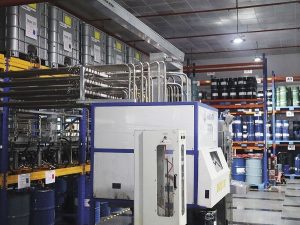
The growth of Parakh Flexipacks by more than four times in the past decade is both comprehensive and astounding. It is ready for change and adaptation to the market and clearly poised in an attitude of looking at the future.
The Bhandgaon plant has had a total architectural, landscaping and production workflow makeover that makes it a world class operational and safety compliant facility. It now has four W&H blown films lines, the latest just added in the past quarter, a 7-layer Varex line from W&H. (In 2017 Parakh purchased back and re-installed the original W&H blown film line and Primaflex CI flexo press which it had divested to its former joint-venture partner Cargill.) Both of these are working to extremely high quality and production standards.
Two more higher speed CI Flexo presses have been integrated, a W&H Miraflex and a Bobst F&K CI flexo 10-color 500 meters a minute press with GPS automation. Fast Nordmeccanica combination laminators and SP Ultra flex slitter rewinders have also been added. A completely new converting section with extensive pouching equipment gives an added value dimension to the plant.
Parakh Flexipack now has a capacity of producing 1000 tons plus a month of innovative and high barrier blown films. It has controlled its own flexo platemaking right from the start in 2010 it was the first company in India (and possibly still the only one) to put in an fully automated ink dispensing plant from Siegwerk that allows it formulate its own inks from standard components and to reuse its own leftover inks. which is a strong support for it going further by innovating. Colour standardisation and reduced colour matching times and low inks wastages are a major achievement and a step towards sustainability.
In 2009 Parakh partnered Finnish company Elecster which is the world’s largest for producing UHT milk pouches. It counts about top 20 dairy brands in India as customers as well as several overseas UHT milk producers. The company has implemented good practices and a very high standard of safety as it has redesigned and expanded the plant with the requisite compliances and certifications that make it a major exporter of high value and high resolution printed flexible packaging materials. It has also made its name in the personal hygiene films and laminates sector with polymer to pouch concepts.
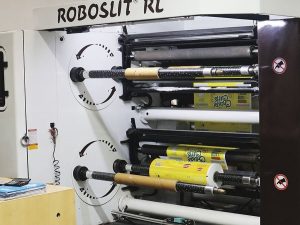
Parakh Flexipacks is seen by industry professionals as one of the best, technically proficient, customer and supplier friendly companies in the industry. It is seen as a humane and fair company, in short, ‘as a good place to work’ with the lowest employee attrition in the Indian packaging scenario. It could be considered as having the lowest employee attrition rate in the Indian packaging scenario.
Overall Parakh Flexipacks has built up in the past decade a strong group of professionals who tackle the day to day operations and departments within the company. With a high level of in-house technical capability, apart from flexo prepress, innovative blown film production including UHT films, flexo printing and converting and the automated ink mixing plant there are trained resources for the maintenance of the Varex dies. This is fairly unusual for a flexible packaging company in India, but extremely handy for a company with four multi-layer blown film lines.
Poised for growth and sustainability
When we ask Parakh Flexipacks’ chief executive officer Vinay Nalawade about how the company is looking at the coming future, it is clear that sustainability, innovation, reduced carbon footprint and exports are high on the list. He is keen to innovate to make flexo more competitive but also to keep good margins. “We want to produce high level quality flexo print with a reduced number of colors to optimize packaging costs. Our new W&H 7-layer line can also yield innovative high barrier and sustainable films. And exports where we are already above 25% of our output is an area that we plan to grow. We went into exports when we felt ready to compete with the best in the flexo markets in the world and this had a positive impact on our profitability and growth. Parakh Flexipacks is very close to minimizing the gap between flexo and roto in print resolution and overall operational costs. Lastly, there may be some interesting surprises from us in days to come.”





